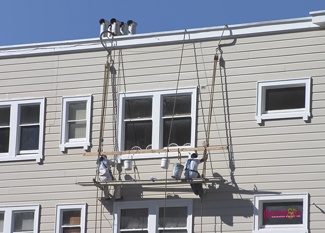Snow accumulation on roofs and the dangers it presents.
This message is a reminder from the Department of Public Safety and the Department of Fire Services.
The February 8th winter storm that hit Massachusetts presents a variety of challenges. As we approach the new week, it is anticipated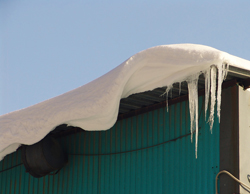 that warm temperatures and rainfall may blanket portions of Massachusetts . With the recent heavy snowfall, rain will increase the weight of snow on roofs throughout the Commonwealth. Fire and building services need to plan for the onset of storm related issues.
that warm temperatures and rainfall may blanket portions of Massachusetts . With the recent heavy snowfall, rain will increase the weight of snow on roofs throughout the Commonwealth. Fire and building services need to plan for the onset of storm related issues.
Flat roofs, lower roofs that meet higher roofs, and areas with parapets or areas of drifting snow are major concerns. Many commercial building owners may hire or bring staff on to clear snow from flat roofs to help ease the burden of additional weight. In doing so, they will also make it easier for fire services to access and traverse these areas in the event of an emergency. In areas of significant snowfall consideration should be given to the additional weight firefighters may contribute on these roofs.
Homeowners, tenants, and businesses should be cognizant of the dangers posed by heavy snow loads on roofs, and the warning signs of potential structural weaknesses. In most instances, risks posed by accumulated snow on roofs may be mitigated by safely removing the snow. from roofs of both commercial buildings and homes. As temperatures are expected to rise and fall over the next several days, every effort should be undertaken now to safely remove snow from roofs.
Removing snow from rooftops will minimize the likelihood of structural collapse. Flat and low pitched roofs, most often found on industrial buildings, but are also used in certain home designs, are at the greatest risk of buckling under heavy snow and ice accumulations. Lower roofs, where snow drifts or accumulates from higher roofs are also vulnerable.
Did you know that a cubic foot of dry snow weighs about seven pounds? While a cubic foot of wet snow may weigh up to 20 pounds. So, if at all possible, consider hiring someone to help with all of the snow clearing.
Here are some helful tips for a Homeowner in the removal of snow and ice from roofs and other areas.
Wear protective headgear and goggles when performing any of these tasks.
Use a snow rake for pitched roofs (available at most hardware stores) to remove snow from your roof.
Start from the edge and work your way into the roof.
Keep gutters, and drains clean, free of ice and snow and keep downspouts clean at ground level.
Try to shave the snow down to a 2 or 3 inches on the roof instead of scraping the roof clean, which will risk damage to your shingles or other roof covering.
Shovel snow from flat roofs throwing the snow over the side away from the building. Most plastic shovels are better, except for the ones with curved blades-those too will do some damage to your roof.
Remove large icicles carefully if they’re hanging over doorways and walkways. Consider knocking down icicles through windows using a broom stick.
Consider hiring professionals to do the job. The combination of heights plus ice makes this one of the more dangerous house chores.
If you don’t hire professionals, at least have someone outside with you in case anything does go wrong.
Keep in mind that any metal tool could conduct electricity if it touches a power line and metal tools may cause damage to the roof.
Here is list of things that homeowners SHOULD NOT do.
Don’t use open-flame devices to remove snow and ice.
Unless approved by a registered professional engineer, don’t add your weight or the weight of equipment to the roof.
Don’t use electric heating devices like hair dryers or heat guns to remove snow and ice.
Don’t use a ladder since ice tends to build up on both the rungs of the ladder and the soles of your boots.
There are several ways to recognize problems with the roof.
Sagging roof
Creaking, cracking or popping sounds
Cracked or split wood members
Bends or ripples in supports
Sheared off screws from steel frames
Sprinkler heads that have dropped down below ceiling tiles
Severe roof leak
Doors or windows that are difficult to open
Bowed utility pipes or conduit attached at ceiling
Cracks in walls or masonry
Here are some other safety tips for homeowners.
Clear snow away from downspouts so water has a place to go.
Never use cooking equipment intended for outside use indoors as a heat source or cooking device.
Do not be tempted to use a heat gun or open flame torch to melt the ice; the risk of starting a fire is huge.
If you feel you are in immediate danger, get outside and call 9-1-1.
Never use your oven for heat.
Space heaters need space, so use them in a 3-foot circle of safety; free of anything that catch fire. Space heaters are not designed to replace your central heating system; they are only designed to provide a little extra heat on a temporary basis. So be sure to turn them off when you leave room or go to bed at night.
Clear snow away from furnace and dryer exhaust vents to prevent carbon monoxide poisoning.
Make sure you smoke alarms and carbon monoxide detectors are working.
Check your outside fuel (furnace) and dryer exhaust vents, making sure that they are not obstructed by snow or ice.
Here are some other safety tips for Business owners.
If you are going to use a snowblower, make sure that it has been approved by a structural engineer to be used on a roof, and that the blower is set to a high level above the roof so as not to damage roof membrane.
Keep gutters, downspouts and drains clean.
Shovel snow from flat roofs throwing the snow over the side away from the building.
Try to shave the snow down to a 2 or 3 inches on the roof instead of scraping the roof clean, which will risk damage to your shingles or other roof covering.
Keep in mind that any metal tool could conduct electricity if it touches a power line.
Use a snow rake for pitched roofs ( available at most hardware stores) to remove snow from your roof.
Remove large icicles carefully if they’re hanging over doorways and walkways.
Always wear protective headgear and goggles when performing any of these tasks.
Most plastic shovels are better, except for the ones with curved blades-those too will do some damage to your roof.
Start from the edge and work your way into the roof.
There are several ways to recognize problems with the roof on Commercial Buildings.
Sagging roof steel – visually deformed
Cracks in welds of steel construction
Water puddles where it never has before
Bowed utility pipes or conduit attached at ceiling
Creaking, cracking or popping sounds
Bends or ripples in metal supports
Severe roof leaks
Sheared off screws from steel frames
Doors that pop open
Doors or windows that are difficult to open
Cracks in walls or masonry
Cracked or split wood members
Sprinkler heads pushed down below ceiling tiles
What to do if you have these problems.
Call your local building or fire department.
If there is imminent danger, evacuate the building and call 911.
What other assistance is available?
Many fire departments have regional technical rescue teams available to local departments in case of collapse.
Massachusetts Task Force 1 is an Urban Search and Rescue Team in Beverly . The team is comprised of Police, Fire, EMS and Civilians who respond to major disasters under a contract with the Federal Emergency Management Agency (FEMA). Currently there are 150 people on the MATF-1 team.
How to remove ice dams from roof safely.
Winter presents homeowners with many unique challenges as the weather changes. Among the winter-fueled obstacles that come each year, ice dams can be one of the most serious. Ice dams that build along the edges of the roof can add to the amount of snow and precipitation that will accumulate. A snow-packed roof is bad news. Preventing the accumulation of ice on the roof edge should be a regular part of every homeowner’s annual winter preparation.
Ice dams form because of the roof’s uneven temperature. The roof becomes heated directly above the interior spaces of the house. 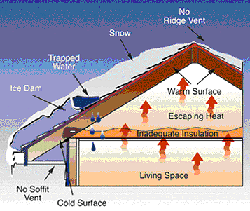 However, this heat does not reach the edges and the overhang. As a result, melted snow and rain will flow to these areas where it will freeze once again. Allowing your roof to maintain an even temperature starts with insulation. Your goal is to stop warm air in the house from flowing into the attic. To do this, seal all the gaps in addition to ensuring that all of the insulation is in good shape. The ideal temperature for the roof deck itself is 30 Fahrenheit. When the entire roof maintains a consistent temperature, the snow eventually clears evenly and naturally. It is also critical to have good ventilation between the roof deck and the insulation. Poor ventilation leads to the accumulation of moisture in this area. Excess moisture compounds your problems by encouraging lamination deterioration and mold growth.
However, this heat does not reach the edges and the overhang. As a result, melted snow and rain will flow to these areas where it will freeze once again. Allowing your roof to maintain an even temperature starts with insulation. Your goal is to stop warm air in the house from flowing into the attic. To do this, seal all the gaps in addition to ensuring that all of the insulation is in good shape. The ideal temperature for the roof deck itself is 30 Fahrenheit. When the entire roof maintains a consistent temperature, the snow eventually clears evenly and naturally. It is also critical to have good ventilation between the roof deck and the insulation. Poor ventilation leads to the accumulation of moisture in this area. Excess moisture compounds your problems by encouraging lamination deterioration and mold growth.
Soffit vents are also a valuable tool for fighting ice dams. These kinds of vents allow cold air to circulate beneath the entirety of the roof. Additional material that ensures seals may be needed during the winter as well. Adding extra insulation in extreme conditions never can hurt. Ice damming could also be related to the deterioration of the flashing around chimneys and other roof gaps. Sealing and insulating ducts and duct pipes that flow through the roof and attic also keeps heat from leaking towards the underside of your roof. Fiber-reinforced mastic on the joints of HVAC ducts can do wonders for heat retention.
In the event that you are experiencing ice dams during the winter, there are a few symptoms that indicate that you may have a problem. Ice dams on the roof will cause specific areas of the roof to transmit cold temperatures. Despite insulation, the area where the ice dam has formed will transmit its lower temperatures through to the trusses that connect with your ceiling. As this cold spot comes in contact with the home’s warm air, condensation occurs. The moisture traps dust and eventually forms mildew that will appear darker than the rest of the ceiling. When this occurs, begin by bleaching the mildewed surface. In some cases, this cleaning will be enough to remedy the problem. However, excessive staining can require a stain-blocking primer and a layer of paint. Should the trusses become cold enough to actually shift as they contract, you are likely to see cracks appear along the joint of the ceiling and the wall. These cracks can be caulked temporarily. The best long-term solution is to cover the joints with molding. Attach the molding only to the ceiling so that it is free to move with the structure as the temperatures fluctuate.
Tips to help with ice dams
Making a homemade Ice melt socks by using old panty hose can create melt channels in the ice dam. These channels will allow melted 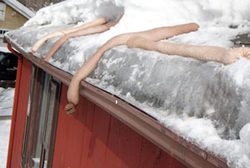 water from your roof to drain off your roof, reducing the ice dam effect. This method may look & sound funny, but it is one of the safest way to create a melting path without heating cables or chipping away at ice dams. Make sure you use ice melter that is safe for your roof, check with your local hardware expert on this prior to using.
water from your roof to drain off your roof, reducing the ice dam effect. This method may look & sound funny, but it is one of the safest way to create a melting path without heating cables or chipping away at ice dams. Make sure you use ice melter that is safe for your roof, check with your local hardware expert on this prior to using.
Always take caution when attempting to remove any ice damn, consult with a professional first. Your safety comes first.
Bundling your home and auto insurance can save you money.
Bundling (combining) your auto and home insurance policies together with the same Insurance Company and Agent can be one of the best ways to save money on Insurance costs. In fact, bundling policies provides one the highest discounts available, on both policies.
together with the same Insurance Company and Agent can be one of the best ways to save money on Insurance costs. In fact, bundling policies provides one the highest discounts available, on both policies.
The reason that insurance companies give their best discounts to their customers who have multiple policies is that it is the easiest way they have to attract and keep new business. A customer who is saving hundreds of dollars by keeping all of their policies with the same insurance company is more likely to move their business to qualify for the savings and much less likely leave(once they have the discount in place). Insurance companies are always looking for ways to acquire additional business, that doesn’t cost them a lot of time, effort, or money to keep. It is just that simple and keeping business simple means savings to the insurance company as well as you, the customer!
For the customer, there are several additional benefits besides saving a money. Customers get the convenience of having all of their policies with one Agent and that means being able to deal with the same individual on a consistent basis. This often means just one bill to pay, making monthly budgeting a lot easier. In the event of an Claim emergency or disaster, having all of your policies together with the same agent or company means peace of mind and, once again, that comes from dealing with the same individuals that you have a strong relationship with. Some companies will even assign the same adjuster to all of your policies. In the event that you have to claim on multiple policies, this can make life a lot easier since you will not have multiple insurance companies trying to get the other one to pay out on your claims.
Keeping your car and home insurance with the same agent and company is a great idea for people living in Dudley MA, Webster MA and Oxford, MA areas. It allows these customers to save money and simplify their lives.
Teenage Drivers and Automobiles, protect your assets
We recommend that parents, in order to best protect assets, consider registering and insuring a vehicle in their child’s name. In Massachusetts parents are provided 100% insulation from lawsuits arising from bodily injury or property damage claims.
registering and insuring a vehicle in their child’s name. In Massachusetts parents are provided 100% insulation from lawsuits arising from bodily injury or property damage claims.
Mass. MGL Chapter 231, section 85A: “If a car is registered to the child and the child gets into an accident causing personal injury and/or property damage, there is no reponsibility on the parent. It does not make any difference who bought the car or who pays for the insurance, or how old the child is so long as we are talking about negligence.”
On this basis it might make sense for parents to consider insuring a vehicle in their child’s name.
The importance for property owners to hire only insured contractors.
Hiring only insured contractors can provide a safeguard for your business. The Property that you own can face significant liability if a contractor does not complete the work both properly and appropriately or if he is injured while on the job. O’Connor & Co. provides Property Owners’ insurance as well as Contractors Liability insurance to clients throughout Central Massachusetts.
All contractors that you hire should be licensed as well as insured. A contractor who is licensed must often pass a background check, possess a specific amount of experience, and pass a business management exam. Most contractors will not receive a license if they have outstanding legal complaints that have not been resolved.
Although unlicensed contractors often offer to work at decreased pricing your savings come at your own expense! The reason is that these savings are due to their lack of insurance and employee benefits such as Workers Compensation. Hiring unlicensed or uninsured contractors can be painfully problematic and costly. For example, you may not have recourse against these contractors if there is an ordinance that is neglected or improperly adhered to. A court may even consider your contract null and void in any action you may need to take against an unlicensed contractor. The court may refuse to provide you with relief or recourse against the contractor based upon your own willing participation in certain situations. With a licensed contractor, you have the right to make a complaint against his license. This option provides you with a way to respond if the work that is done is below an objective standard of quality workmanship or below the building codes in your area. You may also be able to receive compensation from a recovery fund in order to have the work corrected or in order to hire a different contractor to complete the work.
A contractor’s failure to comply with Workers Compensation requirements or other legal responsibilities, while working on your property, can have devastating implications for you as a property owner. Remember, ignorance of the law is not a viable legal defense and it is always the property owners responsibility to verify that the people hired are working within the law.
O’Connor & Co. can provide you with property owners’ insurance as well as other valuable advice on how to protect your most treasured assets. Hiring properly insured and licensed contractors is only one of the valuable pieces of advice that we offers.
Leading causes of house fires and tips for your items in your home.
Fires can be a devastating event and all of us at O’Connor & Co. Insurance we hope you never have to experience such a traumatic event.
We at O’Connor have compiled a list of some of the leading causes to home fires. We hope this blog will help you take some extra precautions.
The latest reported figures, accidents attributed to cooking generated more residential fires more than any other known cause. The leading cause of residential fire deaths is careless smoking.
We also provide a link to a free home inventory checklist at the bottom of this page.
Some of causes of reported fires include:
- Cooking 20%
- Unknown 18%
- Heating 15%
- Suspicious Causes (arson) 11%
- Appliances 8%
- Smoking 5%
- Open Flame 5%
- Children Playing 4%
- Other 4%
- Exposure 3%
3 Tips for inventorying for your home.
- Take a video camera through your home and verbally describing all the items in your home.
- Take pictures with a time stamp on the image. On the back of the image, list the value, serial number, make and model number. If you’re storing it electronically, name the pictures and reference the description.
- If you have an iPhone® download a free app from the National Association of Insurance Commissioners, myHOME Scr.APP.book app. It guides you through capturing images, writing descriptions, saving bar codes and serial numbers, and stores them all electronically.
Are you eligible for affordable flood insurance?
The wild weather this year through the United States, ranging from 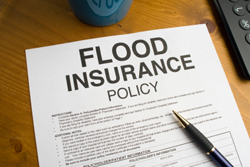 hurricanes, tornadoes, snow storms and long periods of rain have caused havoc throughout the Northeast in particular. At times, you might feel like an ark might be a good investment. We have received a lot of questions from our customers about flood insurance and if their homeowner’s policy covers flooding. We hope these questions can be answered and we welcome your phone calls at O’Connor & Co. Insurance. Feel free to call us with any questions at 508-943-3333.
hurricanes, tornadoes, snow storms and long periods of rain have caused havoc throughout the Northeast in particular. At times, you might feel like an ark might be a good investment. We have received a lot of questions from our customers about flood insurance and if their homeowner’s policy covers flooding. We hope these questions can be answered and we welcome your phone calls at O’Connor & Co. Insurance. Feel free to call us with any questions at 508-943-3333.
Does My Homeowners Policy Cover Flooding?
- Flood damage is not covered by homeowner’s insurance policies. You can protect your home, business, and belongings with flood insurance. You can insure your home for up to $250,000 for the building and up to $100,000 for the contents.
Who Can Get Flood Insurance?
- Anyone can get flooded, and anyone can get flood insurance. Even if you have been flooded before, live in a flood zone, or if your flood risk is high, medium, or low, you can purchase flood insurance if your community participates in the NFIP.
Is Flood Insurance Affordable?
- The average flood insurance policy costs a little more than $300 a year for about $100,000 of coverage. A policy for a dwelling in low- to moderate-risk areas may be as low as $100 a year.
Is There a Waiting Period For Flood Insurance?
- Yes, there is a 30-day waiting period before a flood insurance policy becomes effective. You can purchase flood coverage at any time, but there is a 30-day waiting period after you have applied and paid the premium before the policy becomes effective.
Is Flood Insurance Less Expensive Than A Disaster Loan?
- Insurance is less expensive than federal disaster loans. Average annual premiums for NFIP coverage are significantly less than loan payments, even though those loans are granted under favorable terms.

